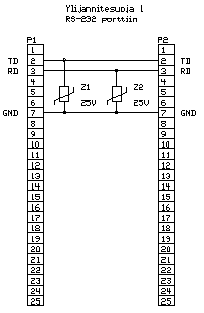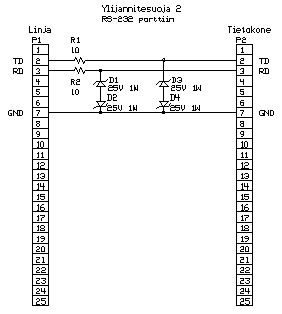RS-232 surge protection
Copyright 1995 Tomi Engdahl
RS-232C serial port lines are quite prone to be damaged by overvoltages. The damaged to computer serial ports have become more and more expensive to replace because of higher intergaration: usually you have to buy new motherboard if one serial port in it gets broken.
So it is wise to use some extra protection in situations where overvoltages surges are quite propabe and repairing gets expensive. For examples of this type of situations are long serial port lines side the building and situation where the computer is connected to ungrounded outlet or the electricity distribution wiring is is not well organized.
Protecting RS-232 serial port against overvoltages usually quite easy. The standard says that the signal can be voltage between +25 and -25 volts, so anything outside this range is not allowed. Typical RS-232C receiver chips can handle well voltages up to +/-30V. So an overvoltage protection which cuts out everyhing above 25V and acts fast is the solution. Suitable components for this are varistors (VDR), zener diodes and other fast semiconductor based overvoltage protection devices.
Another question is what needs to be protected. The answer is that every communication line wire which is connected between computers must be protected. In simplest case there are only transmit data, receive data and ground lines used. In this case only protection componets are needed: one between transmit data and ground and another between receive data and ground. If more lines are used, then all of then must be protected with a protection component between signal wire and signal ground.
In bad overvoltage situations is is recommended to use galvanic isolators in serial port lines or use serial data converters which provide isolation and protection (short haul modems, current loop adapaters etc.).
The circuits
The following circuit are provded here to give your idea how the overvoltage protecton circuits really work and how you can easily add some protection to your circuits. To make theose circuit really effective need careful component choosing and good construction. For best performace I recommend using commercial units from realiable data communication product manufacturers.

RS-232 surge protector circuit using VDRs
This first circuit is a simple VDR based protector circuit which is very similar to one inexpensive commercial protection circuit. VDRs have quite big surge handling capacity and are quite fast so they are directly suitable for protection.

RS-232 surge protector circuit using zener diodes
This another circuit is based on zener diodes and the basic idea is quite similar to some commercial circuits also. The zener diode is faster to react to the surges than those VDRs so they provide better protection. Zener diodes also have lower capacitance than VDRs, so they suite better for high speed data lines. Unfortuantely the surge capacity of those zener diodes is not very high, so that they can't handle the large spikes by themselves. That's why I have added 10 ohm resistors in series with data line before the zener diodes. This resistor limits the surge current to safer value for zener diode. The resistor must be always be between the data line and zener diode, so you mut plug this circuit in the way where the computer goes to the connector on the right and the data line to the connector on the left. It is possible to make this circuit "bidirectional" just by adding also resistors to the computer side of the zener diodes, but this increased the resies resitance in the data line.
Ideas for improving protection circuits
For getting better protection for serial port, there are some ideas to make those circuits more effective. The improvements are using frame gound pin (pin 1) for common gounding pin to surge protector elements instead of using data ground pin (pin 7). Another improvements is to add protection also to the handshaking lines.
For example B&B Electronics 232DSP surge protector uses freme gound pin 1 as the common gounding point for surge protectors. The surge protecting elements are 26V metal oxide varistors. Varistors are installed for protecting all pins 2 through 8 and also pin 20. In this way all data and handshaking pins needed for normal RS-232 asyncronous serial connection are protected.
Using those same ideas you can easily make your own RS-232 serial port protection circuits which suit to all your needs.
Tomi Engdahl <[email protected]>









